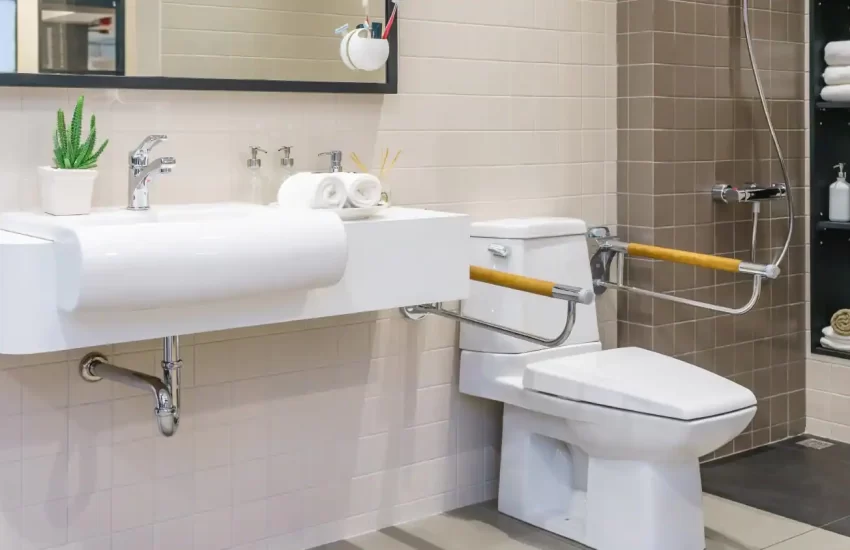Few materials provide more bang for your buck than bathroom tiles, which are practical, easy to maintain, and highly customizable according to personal style.
Large floor and wall tiles create a sleek and stylish minimalism in your home that provides endless design opportunities. Many options come in large sizes with rectified edges for cleaner finishes with less grout lines.
Ceramic
Ceramic tiles come in many different shapes, sizes and finishes to fit into any design scheme. Their water resistance makes them an excellent choice for floors, countertops and walls alike.
Ceramic tile is comprised of compressed clay, silica sand, dyes and other raw materials that have been compressed under intense pressure before going through one or more processes of heating and cooling. There are various varieties of ceramic tiles, all categorised according to porosity and hardness.
Class 1 ceramics offer low porosity and hardness for use in areas that experience light wear such as bathroom floors and walls, such as those exposed to showering water. Porcelain on the other hand is denser and more resilient compared to ceramic; additionally it comes with precut edges for near perfect sizing compared to rectified porcelain pieces.
This means simpler installation, reduced grout lines and longer lasting tiles. For this bathroom design project, the designer chose marble penny-sized hexagon tiles underfoot to replicate rocky pebbles and complement its eye-catching insect wallpaper.
Marble
Marble is an ageless material for bathroom walls and floors that exude luxury, perfect for grand decor reminiscent of ancient Rome or the 19th-century French Ecole des Beaux Arts.
Metamorphic stone’s beauty lies in its distinctive veining that ranges from white to black depending on its mineral content, giving each tile a distinct appearance and adding visual interest to your space.
Since marble is porous, it needs to be sealed regularly and any spills must be addressed quickly in order to avoid etching and staining. Marble tiles tend to be more costly than other options available on the market.
Porcelain
While porcelain tiles and ceramics appear similar, there are distinct differences between the two materials. Determining whether a tile is porcelain or ceramic involves more than visual inspection and water absorption tests – its manufacturing process plays a crucial role.
Porcelain stands out as an outstanding material due to its density. Being hard and dense means it is more resistant to staining or damage, making porcelain suitable for areas such as floors, showers and tub surrounds where humidity may exist.
Porcelain tiles are created by pressing a fine clay mixture into molds and firing it in a kiln at high temperatures, producing smooth surfaces which are then coated in glaze to create their color or pattern, with any necessary slip resistance being added later for safety purposes. They are often preferred over ceramic due to its higher resistance to water; additionally rectified forms provide near perfect edges when cut for precise measurements when cut.
Mosaic
Mosaic tiles are one of the most versatile design elements in any bathroom, providing endless design opportunities. Used on walls, floors and even tub/shower surrounds for intricate patterns to add visual interest, mosaic tile comes in an assortment of materials, sizes and colors so it can be tailored to any look imaginable.
Mosaic tiles come in both pre-set patterns for borders or you can turn to companies specializing in mosaic design to create murals or pictures using mosaic tiles. Installation usually requires placing mosaics onto mesh fiberglass backing for faster and simpler application.
Tile can make any space appear bigger or smaller depending on its placement in a room, using these design ideas to find the ideal tile for your bathroom renovation project.


 Customizable Bathroom Fixtures – Tailoring Your Space
Customizable Bathroom Fixtures – Tailoring Your Space  5 Easy Ways to Incorporate Artistic Elements in Your Kitchen
5 Easy Ways to Incorporate Artistic Elements in Your Kitchen  Smart Budgeting for Your Home Improvement Projects
Smart Budgeting for Your Home Improvement Projects  The Role of Glass Repair and Replacement in Preserving Architectural Integrity
The Role of Glass Repair and Replacement in Preserving Architectural Integrity  Accessible Bathroom Design – Making Bathrooms Safe and Comfortable for Everyone
Accessible Bathroom Design – Making Bathrooms Safe and Comfortable for Everyone  Manchester Kitchen Fitters Unveiled: How to Make the Right Choice
Manchester Kitchen Fitters Unveiled: How to Make the Right Choice  Bathroom Tiles Are Practical, Easy to Clean and Highly Customizable
Bathroom Tiles Are Practical, Easy to Clean and Highly Customizable 

